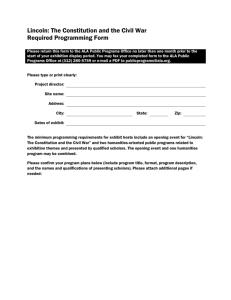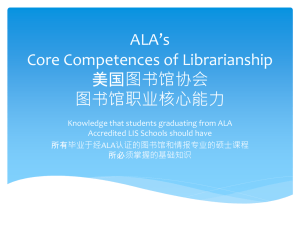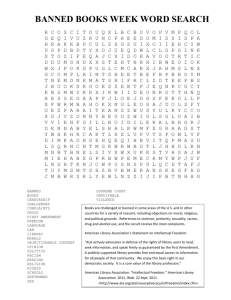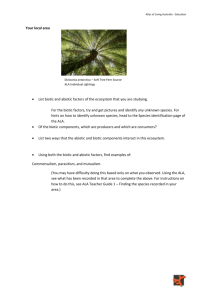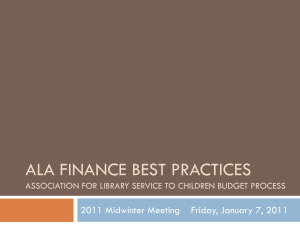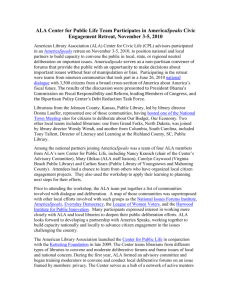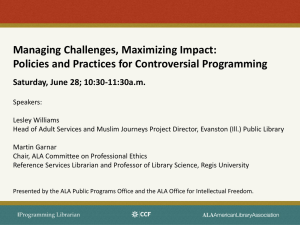Civil War and Reconstruction: 1860s to 1877
advertisement
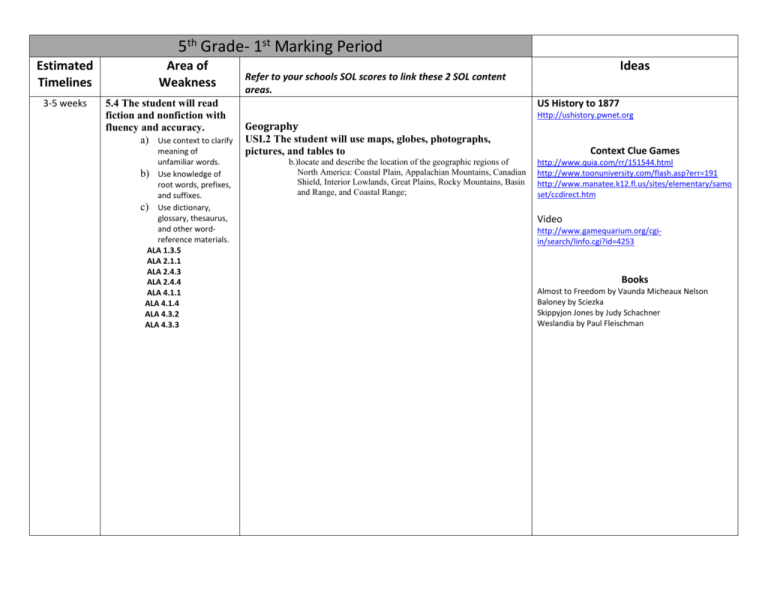
5th Grade- 1st Marking Period Estimated Timelines 3-5 weeks Area of Weakness 5.4 The student will read fiction and nonfiction with fluency and accuracy. a) Use context to clarify meaning of unfamiliar words. b) Use knowledge of root words, prefixes, and suffixes. c) Use dictionary, glossary, thesaurus, and other wordreference materials. ALA 1.3.5 ALA 2.1.1 ALA 2.4.3 ALA 2.4.4 ALA 4.1.1 ALA 4.1.4 ALA 4.3.2 ALA 4.3.3 Ideas Refer to your schools SOL scores to link these 2 SOL content areas. US History to 1877 Geography USI.2 The student will use maps, globes, photographs, pictures, and tables to b.)locate and describe the location of the geographic regions of North America: Coastal Plain, Appalachian Mountains, Canadian Shield, Interior Lowlands, Great Plains, Rocky Mountains, Basin and Range, and Coastal Range; Http://ushistory.pwnet.org Context Clue Games http://www.quia.com/rr/151544.html http://www.toonuniversity.com/flash.asp?err=191 http://www.manatee.k12.fl.us/sites/elementary/samo set/ccdirect.htm Video http://www.gamequarium.org/cgiin/search/linfo.cgi?id=4253 Books Almost to Freedom by Vaunda Micheaux Nelson Baloney by Sciezka Skippyjon Jones by Judy Schachner Weslandia by Paul Fleischman CONT.) 5.4 The student will read fiction and nonfiction with fluency and accuracy. a) Use context to clarify b) c) Exploration to Revolution: Pre-Columbian Times to the 1770s USI.3 The student will demonstrate knowledge of how early cultures developed in North America by a) meaning of unfamiliar words. Use knowledge of root words, prefixes, and suffixes. Use dictionary, glossary, thesaurus, and other wordreference materials. b) locating where the American Indians (First Americans) settled, with emphasis on Arctic (Inuit), Northwest (Kwakiutl), Plains (Sioux), Southwest (Pueblo), and Eastern Woodland (Iroquois); describing how the American Indians (First Americans) used their environment to obtain food, clothing, and shelter. First Americans (Native Americans) http://www.kidinfo.com/American_History/Native_A mericans.html Inuit http://www.historyforkids.org/learn/northamerica/be fore1500/history/inuit.htm Kwakiutl http://encyclopedia.kids.net.au/page/kw/Kwakiutl_my thology http://bigorrin.org/kwakiutl_kids.htm http://encyclopedia.kids.net.au/page/kw/Kwakiutl Lakota (Sioux) http://encyclopedia.kids.net.au/page/kw/Kwakiutl Pueblo Correlate http://www.bigorrin.org/pueblo_kids.htm http://www.historyforkids.org/learn/northamerica/be fore1500/history/pueblo.htm Iroquois http://bigorrin.org/iroquois_kids.htm http://www.bigorrin.org/mohawk_kids.htm USI.4 The student will demonstrate knowledge of European exploration in North America and West Africa by a) b) c) Correlate describing the motivations, obstacles, and accomplishments of the Spanish, French, Portuguese, and English explorations; describing cultural interactions between Europeans and American Indians (First Americans) that led to cooperation and conflict; identifying the location and describing the characteristics of West African societies (Ghana, Mali, and Songhai) and their interactions with traders. United Streaming- Spanish Explorers. Watch video, use an atlas to map out Francisco Coronado’s route through the southwest to search for the City of Gold. ( It also helps to tell them that was the same thing Nicholas Cage was looking for in National Treasure 2) 2nd Marking Period Suggested Timeline 2-3 weeks Area of Weakness 5.5 The student will read and demonstrate comprehension of fiction. Suggested Areas of Focus USI.5 The student will demonstrate knowledge of the factors that shaped colonial America by b.)Describe character development in fiction and poetry selections. c.)Describe the development of plot and explain how conflicts are resolved. ALA 4.1.3 ALA 4.2.4 a) b) c) d) Correlate describing the religious and economic events and conditions that led to the colonization of America; comparing and contrasting life in the New England, Mid-Atlantic, and Southern colonies, with emphasis on how people interacted with their environment; describing colonial life in America from the perspectives of large landowners, farmers, artisans, women, indentured servants, and slaves; identifying the political and economic relationships between the colonies and England. Ideas STAR site Websites http://www.history.org/kids/ http://library.thinkquest.org/J002611F/ http://cybersleuthkids.com/sleuth/History/US_History/Colonial_Period/index.htm http://www.academickids.com/encyclopedia/index.php/Coloni al_America at the bottom on the page has links for early exploration and colonial clip art. http://www.socialstudiesforkids.com/wwww/us/uslistcolonial.h tm Games http://www.quia.com/jg/66108.html - matching game http://www.quia.com/rr/4049.html Colonial Millionaire Game Quiz http://www.quia.com/jq/61229.html Web quests http://www.hfmgv.org/educational/smartfun/colonial/in tro/ http://www.bristolvaschools.org/mwarren/JourneytoColonialTi mes.htm create a brochure Books Jean Fritz’ books 2-3 weeks 5.6 The student will read and demonstrate comprehension of nonfiction. Websites c.)Locate information to support opinions, predictions, and conclusions. d.) Identify cause-andeffect relationships. Revolution and the New Nation: 1770s to the Early 1800s USI.6The student will demonstrate knowledge of the causes and results of the American Revolution by ALA 4.2.3 ALA 2.1.3 ALA 2.2.3 a) b) c) Correlate d) identifying the issues of dissatisfaction that led to the American Revolution; identifying how political ideas shaped the revolutionary movement in America and led to the Declaration of Independence, with emphasis on the ideas of John Locke; describing key events and the roles of key individuals in the American Revolution, with emphasis on George Washington, Benjamin Franklin, Thomas Jefferson, Patrick Henry, and Thomas Paine; explaining reasons why the colonies were able to defeat Britain. http://www.kidinfo.com/American_History/American_Revolutio n.html http://www.pocanticohills.org/revolution/revolution.htm eBooks The American Revolution for Kids: A History with 21 Activities By Janis Herbert Books …If you lived at the time of the American Revolution - By Kaye Moore George Washington: and the American Revolution by Don Abnett What do you know about the American Revolution by Lynn George Revolutionary War Days: Discover Past with exciting projects, games, and activities, and recipies by David King Phillis Weatley by Don McLeese 3rd Marking Period Timeline 3-5 weeks Area of Weakness 5.7The student will demonstrate comprehension of information from a variety of print resources. Suggested Areas of Focus USI.7 The student will demonstrate knowledge of the challenges faced by the new nation by b.) Organize information on charts, maps, and graphs. ALA 1.1.6 ALA 2.1.2 ALA 3.1.4*** a) b) c) d) Correlate identifying the weaknesses of the government established by the Articles of Confederation; identifying the basic principles of the new government established by the Constitution of the United States and the Bill of Rights; identifying the conflicts that resulted in the emergence of two political parties; describing the major accomplishments of the first five presidents of the United States. Ideas Bill of Rights Games http://www.ohiokids.org/games/ah/dd01f.html http://www.quia.com/cc/67829.html http://www.quia.com/jfc/67829.html Bill of Rights Graphic Organizer http://lshs.leesummit.k12.mo.us/lshsmedia/LMC/Bill%20of%20 Rights%20Redux%202/BoRGraphicOrg.html Bill of Rights Smartboard http://www.elko.k12.nv.us/ecsdtc/SMART%20Lessons/bill%20 of%20rights.notebook Books The Bill of Rights by Taylor-Butler The Bill of Rights in Translation: What it really means by Leavitt, Amie Jane Graphic Novel- The Bill of Rights by Norman Pearl Presidents http://www.bing.com/images/search?q=Presidents+graphic+or ganizers&FORM=IGRE&qpvt=Presidents+graphic+organizers#fo cal=37d478d762871901529af468ec2f8b3c&furl=http%3A%2F% 2Fwww.nonags.org%2Fmembers%2Fdasaunders%2Factivities% 2Fcomcast%2Factivities%2Funit3%2Frev%2Freasonsdraw.jpg Never mind anything else – this covers it all! 5.6 The student will read and demonstrate comprehension of nonfiction. a) Use text organizers, such as type, headings, and graphics, to predict and categorize information. STAR site Expansion and Reform: 1801 to 1861 USI.8 The student will demonstrate knowledge of westward expansion and reform in America from 1801 to 1861 by a) ALA 3.1.6 ALA 3.1.3 ALA 4.1.6 b) c) Correlate d) describing territorial expansion and how it affected the political map of the United States, with emphasis on the Louisiana Purchase, the Lewis and Clark expedition, and the acquisitions of Florida, Texas, Oregon, and California; identifying the geographic and economic factors that influenced the westward movement of settlers; describing the impact of inventions, including the cotton gin, the reaper, the steamboat, and the steam locomotive, on life in America; identifying the main ideas of the abolitionist and suffrage movements. Lewis and Clark Games & Activities http://www.nationalgeographic.com/west/ http://www.nps.gov/archive/jeff/lewisclark2/activities&kids/A ctivitiesAndKidsMain.htm Invention Websites Cotton gin http://score.rims.k12.ca.us/score_lessons/cotton_gin/pages/re ading.html Reaper http://www.lib.niu.edu/2000/ihy000446.html steamboat http://www.kidscanmakeadifference.org/Newsletter/nf2001b. htm Steam locomotive http://ushistory.pwnet.org/resources/I.8.c.php 4th Marking Period Suggested Timeline 3-5 weeks Area of Weakness 5.6b,e The student will read and demonstrate comprehension of nonfiction. b.)Identify structural patterns found in nonfiction. e.)Identify compare-andcontrast relationships. Suggested Area of Focus Websites Civil War and Reconstruction: 1860s to 1877 USI.9 The student will demonstrate knowledge of the causes, major events, and effects of the Civil War by a) b) c) Correlate d) e) f) 5.7 The student will demonstrate comprehension of information from a variety of print resources. a.) Develop notes that include important concepts, summaries, and identification of information sources. Ideas describing the cultural, economic, and constitutional issues that divided the nation; explaining how the issues of states’ rights and slavery increased sectional tensions; identifying on a map the states that seceded from the Union and those that remained in the Union; describing the roles of Abraham Lincoln, Jefferson Davis, Ulysses S. Grant, Robert E. Lee, Thomas “Stonewall” Jackson, and Frederick Douglass in events leading to and during the war; using maps to explain critical developments in the war, including major battles; describing the effects of war from the perspectives of Union and Confederate soldiers (including black soldiers), women, and slaves. USI.10 The student will demonstrate knowledge of the effects of Reconstruction on American life by Correlate a) b) identifying the provisions of the 13th, 14th, and 15th Amendments to the Constitution of the United States and their impact on the expansion of freedom in America; describing the impact of Reconstruction policies on the South. http://www.socialstudiesforkids.com/subjects/civilwar.htm http://edtech.kennesaw.edu/web/civwar.html http://americancivilwar.com/kids_zone/causes.html http://www.radford.edu/sbisset/civilwar.htm Gettysburg http://www.nps.gov/archive/gett/gettkidz/kidzindex.htm Books Nettie’s Trip South by Ann Warren Turner Pink & Say by Patricia Pollacco The Lincolns: A scrapbook look at Abraham and Mary Civil War Recipies: Adding and Subtracting simple fractions by Lynn George Civil War days: Discover the past with exciting projects, games, activities by David King Red Legs: A drummer boy of the Civil War by Ted Lewin Kids During the American Civil War by Lisa Wroble
